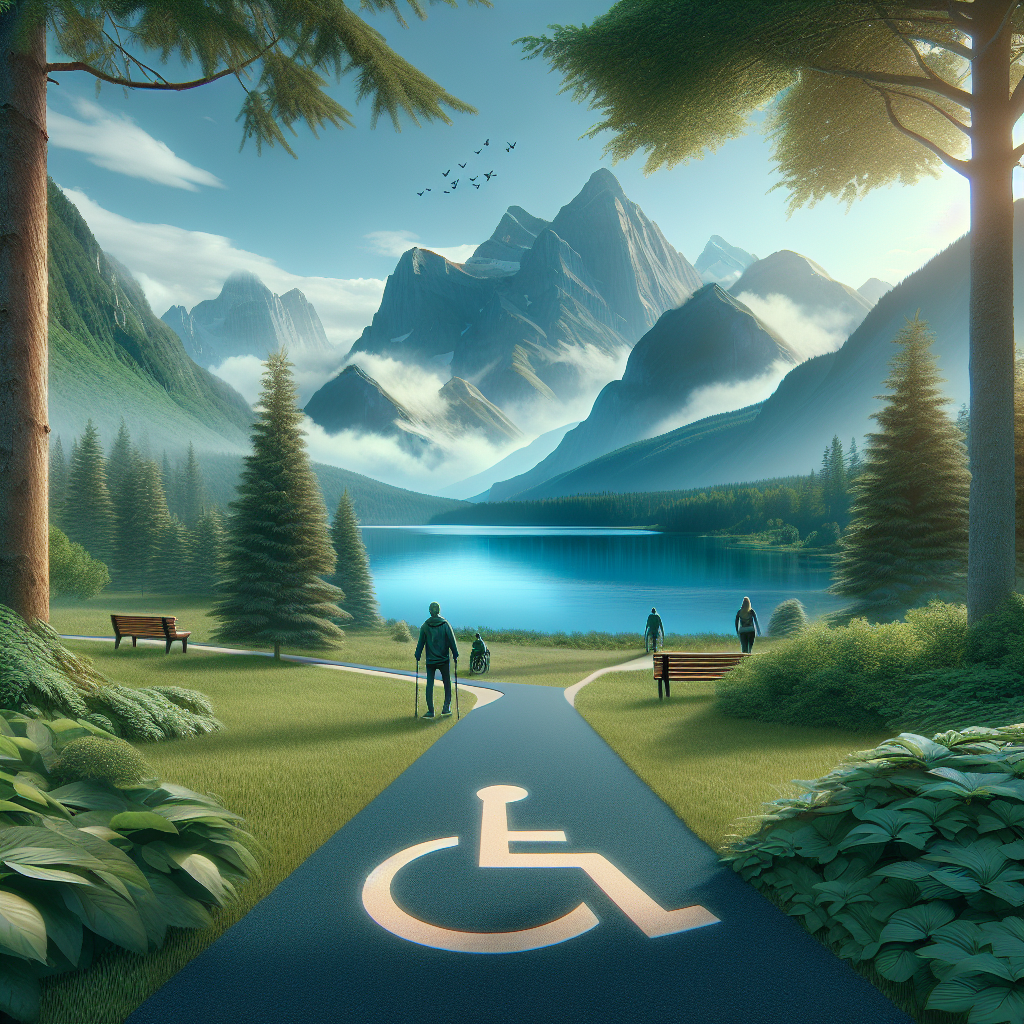Imagine a warm, sunlit day with a gentle, refreshing breeze whistling through the trees. All around you is the calm serenity of nature as you embark on an exhilarating journey into the great outdoors. In “Accessible Hiking: Trails For All Abilities”, you’ll discover numerous fantastic trails catered to everyone, irrespective of your physical abilities or experience. This guide will become your trusted compass as it navigates you through a world of adventurous routes, scenic landscapes, and wheelchair-friendly pathways all designed to make hiking enjoyable and accessible for everyone.
Understanding Accessible Hiking
Hiking can be considered as not just a sport or a hobby, but a passion and a way to connect with nature. But, what if you have mobility constraints? Should this stop you from enjoying the great outdoors? Absolutely not! This is where accessible hiking comes into the picture.
Definition of Accessible Hiking
Accessible hiking, as the name suggests, refers to hiking trails and experiences curated specifically for those with physical or mobility constraints. These trails are designed keeping in mind the specific needs of individuals with disabilities, making it easier for them to navigate through the terrain without significant difficulties.
Common Misconceptions About Accessible Hiking
One of the most common misconceptions about accessible hiking is that it’s only meant for people who are wheelchair-bound. In reality, accessible trails are designed keeping in mind a variety of needs and abilities, catering not only to those who use wheelchairs but also individuals with visual impairments, balance issues, and other physical disabilities. Another misconception is that accessible trails are flat and uninteresting. Contrary to this, accessible trails can offer a range of terrains and stunning viewpoints.
Benefits of Accessible Hiking
Accessible hiking allows everyone, irrespective of their physical capabilities, to enjoy the beautiful landscapes that our world has to offer. It’s a healthy and rejuvenating activity that lifts spirits and fosters a deep connection with nature. It provides an opportunity for physical exercise and boosts mental health by reducing stress and promoting a sense of well-being.
Features of Accessible Hiking Trails
Wheelchair Accessibility
One of the hallmark features of an accessible hiking trail is wheelchair accessibility. They are designed to ensure that people who use wheelchairs can navigate the trail with minor or no assistance. This includes elements such as wide and stable paths, ramped access wherever possible, and minimal obstacles on the trail itself.
Trail Surface and Width
The surface of an accessible trail is generally firm and smooth to facilitate easy navigation. The width of the trails is broad enough to accommodate wheelchairs and assistive devices. In areas where there may be a gradient or slope, modifications are made to make these areas navigable.
Signage and Information Boards
Signage plays a vital role in making hiking trails accessible. Information boards and signs throughout the trail provide vital information about the route, possible obstacles and are visually clear and easy to understand. Braille signage is also used in several trails for visually impaired hikers.
Rest Areas and Comfort Stations
Accessible hiking trails come equipped with rest areas at regular intervals. These areas often include accessible toilets and shaded seating areas for hikers to rest and recharge.
Handrails and Guardrails
In order to provide additional safety and guidance for hikers, accessible trails often feature handrails and guardrails. These aids can be very helpful for those with balance difficulties.

Top Accessible Hiking Trail Suggestions
Domestic (U.S.) Trail Recommendations
The United States boasts of numerous accessible hiking trails that cater to various abilities. Some noteworthy trails include the Glacier National Park in Montana, the Mammoth Cave National Park in Kentucky, and the Yosemite National Park in California.
International Trail Suggestions
Internationally, trail accessibility is also a growing trend. The Capilano Suspension Bridge Park in Vancouver, Canada, and the Senda Litoral in Malaga, Spain, are excellent examples of accessible trails that offer incredible views and rich natural biodiversity.
Trails of Varying Difficulty Levels
Accessible hiking doesn’t just mean easy or beginner level hiking. There are trails available for varying levels of abilities, offering different levels of challenges to suit each individual’s comfort and skill level.
Trails with Great Scenic Views
The beauty of accessible hiking is that it opens up opportunities to experience breath-taking scenic views; The Grand Canyon’s rim trail or the coastal paths of Acadia National Park offer such mesmerising views.
How to Evaluate a Trail’s Accessibility
Online Resources and Guidebooks
There are many online resources, guidebooks, and community forums dedicated to accessible hiking trails. These can provide valuable information such as trail descriptions, terrain details, trail difficulty, and more.
Understanding the Universal Trail Assessment Process
The Universal Trail Assessment Process (UTAP) is a system that provides detailed information about trails, including the trail length, width, surface, and degree of difficulty. This can help in choosing suitable trails based on your specific needs and abilities.
Consulting with Local Park Authorities
Local park authorities are a valuable resource when it comes to understanding trail accessibility. They can provide the most current and accurate information about trail conditions and any potential scheduled maintenance that might affect accessibility.

How to Prepare for an Accessible Hiking Trip
Accessibility Specific Gear
Using the right gear is essential for a comfortable and safe hiking experience. This could include specially designed hiking wheelchairs, walking aids, sturdy footwear, or devices that can make navigation easier.
Researching Weather and Trail Conditions
Checking the weather forecast and current trail conditions is crucial before setting off on a hike. This can help you prepare for potential challenges and ensure your safety while on the trail.
Planning Rest Stops and Meal Breaks
Planning your route with rest stops in mind is a good strategy, it allows for regular breaks to refuel and refresh. Also, be sure to pack enough food and water for your journey.
Safety Tips for Accessible Hiking
Hiking with a Companion
Consider hiking with a companion. Not only can it make the experience more enjoyable, but it also ensures that there’s someone around to provide assistance if needed.
Carrying First Aid Essentials
Ensure that you have a basic first-aid kit in case of minor injuries or emergencies. Include necessary medications and any specific medical supplies that you might need.
Knowing Your Physical Limits
It’s important to know your physical limits and plan your hike accordingly. It’s perfectly fine to start with shorter, less challenging trails and gradually work your way up.
Investing in GPS and Alert Devices
Carrying a GPS and alert devices can be beneficial, especially on more secluded trails. These can help in emergencies and prevent you from getting lost.
Inclusive Practices for Hiking Groups and Organizations
Organizing Accessible Hiking Events
Organizing special events focusing on accessible hiking can make the outdoors a more welcoming space for all. These events can educate people, promote the importance of inclusive design, and provide an opportunity for everyone to experience the joys of hiking.
Creating Inclusive Social Environments
Inclusive social environments are about fostering a culture of acceptance and mutual respect within groups and organisations. This includes consciously working towards eliminating barriers that prevent people from fully participating in activities.
Promoting Representation within Group Leadership
Ensuring diversity in group leadership can aid in making decisions that benefit all members. A diverse leadership brings various perspectives to the table, ultimately leading to a more inclusive and understanding atmosphere.
Sharing the Hiking Experience: Travelogue and Blogging
How to Document Your Hiking Experience
Documenting your hiking experience through photos, videos, or a travelogue can be a great way to share your journey with others. It’s a great way to preserve memories and inspires others to take up the same journey.
Inspiring Others Through Storytelling
Your hiking stories can serve as an inspiration for others. By sharing your experiences and the challenges you’ve overcome, you can encourage others with similar circumstances to take up hiking.
Promoting Accessible Hiking on Social Media
Promoting your hiking experiences on social media channels can help accessible hiking gain more visibility. This in turn can lead to more attention being given to the need for more such trails and facilities around the world.
Benefits of Accessible Hiking for Mental and Physical Well-being
Physical Health Benefits
Hiking is a great form of exercise that helps in improving strength, flexibility, and balance. For people with mobility impairments, accessible hiking can offer a great way to stay active and improve overall fitness levels.
Mental Health Advantages
The mental health benefits of hiking are manifold. It lowers stress levels, enhances mood, and can help improve sleep. The tranquillity and beauty of nature can have therapeutic effects on the mind, providing a sense of peace and relaxation.
Therapeutic Value of Nature
Being in nature can have profound therapeutic effects on a person’s mental well-being. Listening to the sound of birds, gushing water, or the rustle of leaves can have a soothing effect and can help one disconnect from the stress and noise of daily life.
Technological Innovations Supporting Accessible Hiking
Advancements in Wheelchair Technology
Recent advancements in wheelchair technology have made it easier for individuals with mobility challenges to access hiking trails. These include specially designed hiking wheelchairs that can navigate rough terrain, making off-road hiking a reality for wheelchair users.
Access Apps and Online Platforms
Several applications and online platforms provide comprehensive information about accessible hikes, their locations, terrains, and difficulty levels. This information can be useful for planning and organising hiking trips.
Innovative Hiking Gear and Equipment
Innovation in hiking gear and equipment has made hiking a more accessible and enjoyable activity for everyone. This includes assistive equipment such as trekking poles, adaptive backpacks, and more specialized gear designed for hiking enthusiasts with varying physical abilities.
In conclusion, accessible hiking is about making the great outdoors accessible to all, irrespective of physical limitations or constraints. It is an endeavour rooted in inclusivity, empathy, and a true love for nature. It serves as a reminder that nature belongs to everyone and the joy of experiencing it shouldn’t be restricted by physical abilities. Embracing this idea makes the world a more inclusive and better place for all.

